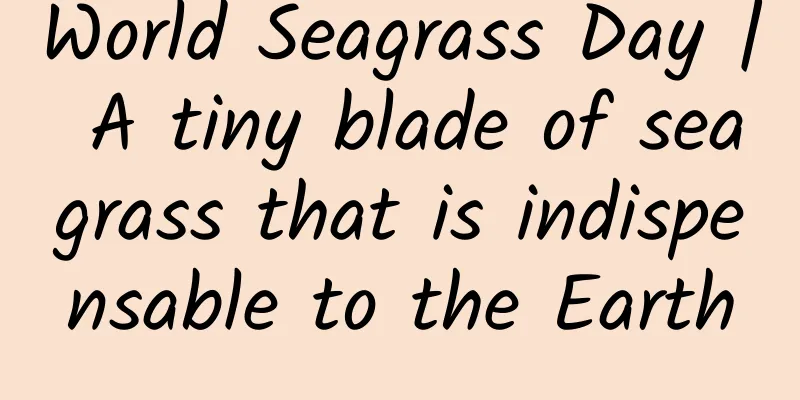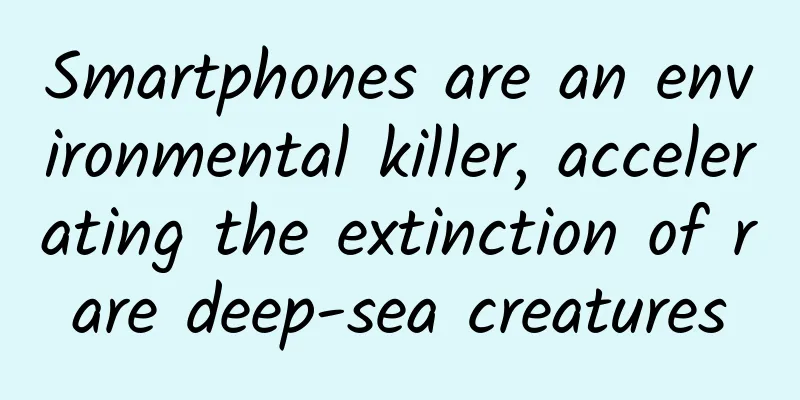World Seagrass Day | A tiny blade of seagrass that is indispensable to the Earth

|
In May 2022, the United Nations passed a resolution declaring March 1 of each year as World Seagrass Day. When talking about grasslands, perhaps the first thing that comes to your mind is the grasslands with white clouds floating and horses galloping, but did you know that there are also such beautiful underwater "grasses" on the seabed. These endless underwater "grasses" are usually called seagrass beds or seagrass meadows. Seagrass on the sandy seabed (copyright image from the gallery, reprinting may cause copyright disputes) 01 Why can seaweed live in water? Seagrass is a flowering higher plant, belonging to the class Monocots of the phylum Angiosperms. Currently, there are 72 species identified in the world belonging to different families and genera. In the process of species evolution, it is believed that it is a plant that has returned to the ocean to grow and reproduce through at least three independent evolutionary events, and has a common ancestor with land plants. Why can it live in water? (1) Compared with terrestrial plants, seagrasses have lost genes involved in stomatal development and the synthesis of volatile substances during the process of evolution, which enables seagrasses to survive in the ocean and resist pathogen invasion. (2) Seagrasses have lost genes that protect against UV rays, while increasing the number of genes related to light capture. (3) Most importantly, seaweeds have restored genes for producing sulfated polysaccharides, which promote water and ion retention in the cell wall, allowing them to maintain normal osmotic pressure in high-salt and high-osmotic pressure seawater. Seagrass of Boidurang Island photographed from Mecca Island (copyright image of the library, reprinting may cause copyright disputes) How does seagrass reproduce underwater? Seagrass consists of roots, stems and leaves. It lives in tropical and temperate coastal waters or coastal estuary waters and can reproduce sexually and asexually. Interestingly, according to reports from Australia, researchers have discovered the world's largest known plant on the Australian coast - a Posidonia seagrass, which covers about 180 square kilometers of shallow sea area on the west coast of Australia and has been growing for more than 4,500 years. Gene sequencing data shows that this "underwater grassland" was spread out by a single seagrass. 02 Seaweed is not only good for the ocean Seagrass beds are found in 159 countries on six continents, covering more than 300,000 square kilometers, making them one of the most widespread coastal habitats on Earth. They provide valuable nursery environments for fisheries, shelter and food for a wide range of marine life, including fish, shellfish and threatened, endangered and rare species such as dugongs, seahorses and green turtles. And seagrass is good for more than just the ocean itself: A pufferfish sleeping in the seaweed (copyright image from the library; reprinting may cause copyright disputes) ▶Resistance to pathogens: Studies have reported that a variety of compounds isolated from seaweed tissue can kill or inhibit a variety of pathogens, effectively reducing the bacterial load in seawater. This not only reduces coral diseases and seafood pollution, but also greatly reduces the chances of fish, invertebrates, and humans coming into contact with pathogens. ▶Dyke protection and disaster reduction: Seaweed, as a rhizome plant growing in the water near the coast, can hold on to the soil and play a role in dyke protection and disaster reduction. Especially when the seawater surges, it can reduce the speed of the current and help the sediment to settle. ▶ Climate regulation: As an important global carbon reservoir, although seagrass beds only cover 0.1% of the seafloor area, they store 18% of the global ocean carbon. This makes it one of the three most productive systems on Earth, along with mangroves and coral reefs, in the marine ecosystem. ▶Restore ecology: Seagrass beds play an important role in the global carbon, nitrogen and phosphorus cycles. They can absorb nitrogen and phosphorus nutrients that exceed their own needs, thereby regulating the nutrient level of the water. Through respiration and photosynthesis, they participate in the ocean carbon cycle, regulate the dissolved oxygen and pH levels of the water, thereby alleviating seawater acidification and enhancing the restoration of ecosystems such as coral reefs. 03 However, underwater grasslands are very fragile According to the United Nations, the global seagrass area has decreased by nearly 30% since the end of the 1900s, and at least 22 of the 72 seagrass species are declining. There are many reasons, but they can basically be attributed to natural and human factors. Seaweed in North Ayrshire, Scotland (copyright image from the gallery; reprinting may lead to copyright disputes) Epidemics Because seagrass meadows are often dominated by a single species, they are vulnerable to epidemics. For example, in the 1930s, an epidemic called "wasting disease" killed nearly 90% of seagrass in the North Atlantic, and during the same period, more than 4,000 hectares of turtle grass died in Florida Bay. Extreme climate In January 2020, the Mediterranean coast of Spain was hit by Storm Gloria, one of the worst climate events in recent years. This caused the falloff and death of young shoots of meadow seagrass, as well as the drifting of sediments and loosening of soil. According to researchers, it may take decades or even hundreds of years for the affected meadows to recover. Human activities Coastal development (reclamation, port construction, dredging, etc.), channel dredging, improper anchoring and boating can cause irreversible damage to seagrass; overfishing, aquaculture, species invasion (private release, etc.) and other activities indirectly affect or even destroy the balanced food web, resulting in a decrease in herbivores, causing algae to grow wildly in the water, and then reducing the amount of light in the water, leading to a decrease in seagrass. In addition, agricultural and industrial runoff and domestic sewage discharge will affect the water body and the marine matrix, causing the degradation of seagrass beds. Smooth ribbon seaweed in the Red Sea (copyright image from the gallery; reprinting may result in copyright disputes) As sentinels of marine ecosystems, seagrasses are sensitive complexes to changes in water quality, sediment loads, and other inputs, and the rise and fall of their growth states foreshadow changes in the environment. When water bodies become eutrophic and water quality declines, seagrass meadows will give way to macroalgae and microalgae and gradually degrade. Their disappearance will threaten tens of thousands of species that rely on them as habitats. At the same time, the disappearance of seagrasses will also affect coastal primary production, carbon storage, and nutrient cycling, as well as reduce energy subsidies to ecosystems in nearshore and offshore areas of the ocean, thereby reducing the secondary productivity of these ecosystems. Imagine if seagrasses disappear, the carbon source stored for hundreds of millions of years will return to the Earth's carbon cycle, which will have a huge impact on global climate change. More importantly, if the current rate of seagrass disappearance continues or accelerates, the damage to the ecosystem will continue to increase, causing more serious economic losses. 04 Protecting seagrass is everyone’s responsibility Seagrass has high requirements for living conditions, and it is very difficult to artificially restore seagrass beds. Traditionally, direct sowing is used, but seagrass seeds are easily impacted by water currents on the seabed, and are retained on the seabed surface and eaten by other animals. Even if the seeds can germinate normally, they are often swept up by waves and hit the shore due to their light weight, and even die. The transplanting method is used to plant and cultivate collected seagrass seeds on land before transplanting them, or to transplant adult seagrass from other healthy meadows. Although some areas have achieved certain results, it also consumes huge manpower and financial resources and the progress is slow. In addition, since these transplanting projects only involve a few seagrass species and regions, from a spatial perspective, they have not been able to stop the pace of seagrass retreat. Through the summary of seagrass transplantation methods and the improvement of management methods, some areas have adopted a system-wide management strategy of "designing science-based management and protection methods, supporting policies and consensus-based rules, reducing the effects of accumulated stress factors, and adapting to the wide impacts on seagrasses to protect them from further impacts", and initial results have been achieved. For example, through 20 years of efforts to reduce nutrient point sources, the total nitrogen load in Tampa Bay, Florida has been reduced by 50%, and the water transparency has increased by nearly 50%, which has restored the seagrass area to 25% of its original total area compared to 1982. Seagrass beds in the Florida Keys National Marine Sanctuary (copyright image from the library; reprinting may result in copyright disputes) Similarly, in a highly eutrophic estuary in Portugal, reducing nitrogen loading in the water column by changing estuary hydraulics and controlling destructive fishing practices increased seagrass area from 0.02 km2 (1997) to 1.6 km2 (2002). Of course, while restoring seagrass beds, the most important conservation measure is to eliminate the factors that cause seagrass degradation, such as trying to avoid excessive input of nutrients and organic matter from agriculture, aquaculture and cities; trying to avoid mechanical damage caused by anchors and fishing gear; controlling overfishing activities in fisheries and maintaining the balance of the marine food web. In view of the important role of seagrass to humans, marine systems and addressing global climate change, in May 2022, the United Nations Conference passed a resolution to establish March 1 of each year as World Seagrass Day to enhance people's awareness of seagrass protection and promote and promote seagrass conservation activities. In this regard, various countries are also actively formulating and adopting corresponding protection and restoration strategies. I hope that while each of us supports the policies of the national and local governments, we can also start from ourselves and take some simple measures to protect the living environment of seagrass, such as not littering, not releasing them privately, saving energy resources, reducing the use of pesticides and insecticides, etc., and caring for every member of our home planet. 【References】 【1】United Nations World Seagrass Day website: http://un.org/events/un-day/world-seagrass-day 【2】Olsen JL, Rouzé P, Verhelst B, Lin YC, Bayer T, Collen J, Dattolo E, De Paoli E, Dittami S, Maumus F, Michel G, Kersting A, Lauritano C, Lohaus R, Töpel M, Tonon T, Vanneste K, Amirebrahimi M, Brakel J, Boström C, Chovatia M, Grimwood J, Jenkins JW, Jueterbock doi: 10.1038/nature16548. PMID: 26814964. 【3】Ugarelli K, Chakrabarti S, Laas P, Stingl U. The Seagrass Holobiont and Its Microbiome. Microorganisms. 2017; 15;5(4):81. doi: 10.3390/microorganisms5040081. PMID: 29244764; PMCID: PMC5748590. 【4】Edgeloe JM, Severn-Ellis AA, Bayer PE, Mehravi S, Breed MF, Krauss SL, Batley J, Kendrick GA, Sinclair EA. Extensive polyploid clonality was a successful strategy for seagrass to expand into a newly submerged environment. Proc Biol Sci. 2022; 8;289(1976):20220538. doi: 10.1098/rspb.2022.0538. PMID: 35642363; PMCID: PMC9156900. 【5】Mazarrasa I, Samper-Villarreal J, Serrano O, Lavery PS, Lovelock CE, Marbà N, Duarte CM, Cortés J. Habitat characteristics provide insights of carbon storage in seagrass meadows. Mar Pollut Bull. 2018; 134:106-117. doi: 10.1016/j.marpolbul.2018.01.059. PMID: 29459167. 【6】Xu S, Xu S, Zhou Y, Yue S, Zhang X, Gu R, Zhang Y, Qiao Y, Liu M. Long-Term Changes in the Unique and Largest Seagrass Meadows in the Bohai Sea (China) Using Satellite (1974–2019) and Sonar Data: Implication for Conservation and Restoration. Remote Sensing. 2021; 13(5):856. https://doi.org/10.3390/rs13050856 【7】R. Costanza, R. D'Arge, R. de Groot, S. Farber, M. Grasso, B. Hannon, K. Limburg, S. Naeem, RV O'Neill, J. Paruelo, RG Raskin, P. Sutton, M. van den Belt. The value of the world's ecosystem services and natural capital. Nature, 387 (1997), pp. 253-260 【8】LM Nordlund, EL Jackson, M. Nakaoka, J. Samper-Villarreal, P. Beca-Carretero, JC Creed. Seagrass ecosystem services – what's next? Mar. Pollut. Bull. 2017, pp. 0-1, 10.1016/j.marpolbul.2017.09.014 【9】M. Waycott, CM Duarte, TJB Carruthers, RJ Orth, WC Dennison, S. Olyarnik, A. Calladine, JW Fourqurean, KL HeckJr, AR Hughes, GA Kendrick, WJ Kenworthy, FT Short, SL Williams. Accelerating loss of seagrasses across the globe threatens coastal ecosystems. Proc. Natl. Acad. Sci. USA, 2009; 106, pp. 12377-12381 【10】R Howarth, et al., Nutrient pollution of coastal rivers, bays and seas. Issues in Ecology. 2000; 7, 1–14. 【11】RJ Orth, et al., A global crisis for seagrass ecosystems. Bioscience. 2006; 56, 987–996. TG Tutin, Zostera L. The Journal of Ecology 1942; 30, 217–226. 【12】MB Robblee, et al., Mass mortality of the tropical seagrass Thalassiatestudinum in Florida Bay (USA). Mar Ecol Prog Ser 1991; 71, 297–299. 【13】Greening H, Janicki A. Toward reversal of eutrophic conditions in a subtropical estuary: water quality and seagrass response to nitrogen loading reductions in Tampa Bay, Florida, USA. Environ Manage. 2006;38(2):163-78. doi: 10.1007/s00267-005-0079-4. PMID: 16788855. 【14】HS Greening, A Janicki, Toward reversal of eutrophic conditions in a subtropical estuary: Water quality and seagrass response to nitrogen loading reductions in Tampa Bay, Florida, USA. Environ Manage 2006; 38, 163–178. 【15】PG Cardoso, A Brandão, MA Pardal, D Raffaelli, JC Marques, Resilience of Hydrobiaulvae populations to anthropogenic and natural disturbances. Mar Ecol Prog Ser 2005; 289, 191–199. 【16】Unsworth RKF, Cullen-Unsworth LC, Jones BLH, Lilley RJ. The planetary role of seagrass conservation. Science. 2022; 377(6606):609-613. doi:10.1126/science.abq6923 【17】Marco-Méndez C, Marbà N, Amores Á, et al. Evaluating the extent and impact of the extreme Storm Gloria on Posidonia oceanica seagrass meadows. Sci Total Environ. 2024; 908:168404. doi:10.1016/j.scitotenv.2023.168404 【18】Lefcheck JS, Wilcox DJ, Murphy RR, Marion SR, Orth RJ. Multiple stressors threaten the imperiled coastal foundation species eelgrass (Zostera marina) in Chesapeake Bay, USA. Glob Chang Biol. 2017;23(9):3474-3483. doi:10.1111/gcb.13623 【19】EI Paling, M Fonseca, MM van Katwijk, M van Keulen, Seagrass restoration. Coastal Wetlands: An Integrated Ecosystems Approach, eds GME Perillo, E Wolanski, DR Cahoon, M Brinson (Elsevier, Amsterdam), 2009; pp. 687–713. 【20】JJ Brouns Impacts of Climate Change on Ecosystems and Species: Marine and Coastal Ecosystems, eds JC Pernetta, R Leemans, D Elder, S Humphrey (International Union for Conservation of Nature, Gland, Switzerland) 1994; Vol 2, 59–72. 【21】Lin 【22】Short F, Carruthers T, Dennison W, Waycott M, Global seagrass distribution and diversity: A bioregional model. J. Exp. Mar. Bio. Ecol. 2007; 350: 3-20 【23】Short F, Polidoro B, et al. Extinction risk assessment of the world's seagrass species. Biol.Conserv. 2011;144(7):1961-1971 Author: A Xiaofan, Master of Institute of Botany, Chinese Academy of Sciences Reviewer: Wang Kang, Director of the Science Museum of the National Botanical Garden, Professor-level Senior Engineer Produced by: Science Popularization China Produced by: China Science and Technology Press Co., Ltd., China Science and Technology Publishing House (Beijing) Digital Media Co., Ltd. |
Recommend
Momo responds to NetEase's criticism: Tang Yan will actively defend himself or face lawsuit
Tencent Technology News Momo updated its prospect...
Analyst: Tesla's sales will quadruple in five years, making it the world's most profitable electric car company
Tesla is now the world's most valuable automa...
What did Cook say to Apple China employees before accepting media interviews?
[[121596]] What did Cook say to Apple China emplo...
Strategies for creating popular articles on Xiaohongshu!
01 About the hot articles on Xiaohongshu 1) For a...
A master of political schemes, ruthless and cruel? Archaeology will help you get to know Cao Cao, who is not mentioned in history textbooks...
On the eve of May Day, the Cao Cao Gaoling Site M...
Can drinking hot water help you lose weight? 15 questions about drinking water, all answered at once
This year's latest "Workplace Health Sta...
“6G Era Accelerator” reconfigurable antenna model, what kind of black technology is this?
Produced by: Science Popularization China Author:...
2024 China Computing Power Conference, how will Henan write a long scroll of computing power?
If we want to feel the historical glory of Henan,...
The data and effects of major mobile game launches are all here!
Mobile game traffic has three main sources: chann...
The hunting suit market is too competitive. The 2025 Song L EV is fully upgraded with more features but no price increase. It starts at 189,800 yuan.
On August 30, the 2024 Chengdu Auto Show official...
Design and implementation of folding panel component
Introduction NutUI should be familiar to everyone...
You lie down, but your brain is still learning at 20 times the speed
Life experience tells us that it is important to ...
Guangzhou fresh food WeChat mini program function, how much does it cost to develop a fresh food WeChat mall mini program?
With the continuous advancement of the Internet, m...
Excellent case study sharing: How was the cost of information flow advertising reduced by 75%?
With the implementation of the housing purchase r...
Is a food wall-breaking machine a nutrient absorption booster? Whether or not food wall-breaking is necessary depends on the ingredients and the person. Come and learn more →
Author: Zhang Yu, researcher at the Chinese Cente...









